A New Validated Rp-Hplc Method For The Determination Of Lumacaftor And Ivacaftor In Its Bulk And Pharmaceutical Dosage Forms
N. Md. Akram*1and Dr. M. Umamahesh2
1Research Scholar, Department of Chemistry, Rayalaseema University, Kurnool, Andhra Pradesh. India.
2Professor and HOD of Chemistry, RGMCET, Nandyal, Kurnool District, Andhra Pradesh. India.
Corresponding Email: mdakram.chem@gmail.com
DOI : http://dx.doi.org/10.13005/ojc/330354
Article Received on :
Article Accepted on :
Article Published : 02 Jun 2017
A New method was established for simultaneous estimation of Lumacaftor and Ivacaftor by RP-HPLC method. The chromatographic conditions were successfully developed for the separation of Lumacaftor and Ivacaftorby using Ineertsil ODS column (4.6×250mm) 5µ, flow rate was 1ml/min, mobile phase ratio (30:10:60v/v) ACN,Methanol,1ml of OPA in 1000ml waterpH 3 (pH adjusted with triethylamine),detection wavelength used by WATERS HPLC Auto Sampler, Separation module 2695, UV detector 2489, Empower-software version-2. The retention times were found to be 3.101 mins and 4.205mins. The % purity of Ivacaftor and Lumacaftor were found to be 100.17 and100.39 respectively. The present analytical method was validated according to ICH guidelines (ICH, Q2 (R1)). The linearity study of Ivacaftor and Lumacaftorwas found in the concentration range 62.5µg/ml-312.5µg/mland 100µg/ml-500µg/mland correlation coefficient (R2) be 0.999 and 0.999, % recovery was found to be 100.13 and 100.53, %RSD for repeatability 0.8 and 0.8, % RSD for intermediate precision was 0.7 and 0.6respectively. The precision study was precision, robustness and repeatability. It is a convenient, simple and quick method for the determination of Ivacaftor and Lumacaftorin its bulk and pharmaceutical dosage forms.
KEYWORDS:Ivacaftor; Lumacaftor; HPLC; Methanol; Acn.
Download this article as:| Copy the following to cite this article: N. Md. Akram*1and Dr. M. Umamahesh .A New Validated Rp-Hplc Method for the Determination of Lumacaftor and Ivacaftor in its Bulk and Pharmaceutical Dosage Forms. Orient J Chem 2017;33(3). |
| Copy the following to cite this URL: N. Md. Akram*1and Dr. M. Umamahesh .A New Validated Rp-Hplc Method for the Determination of Lumacaftor and Ivacaftor in its Bulk and Pharmaceutical Dosage Forms. Orient J Chem 2017;33(3). Available from: http://www.orientjchem.org/?p=33527 |
Introduction
Ivacaftor is Cystic fibrosis is caused by any one of several defects in a protein, cystic fibrosis transmembrane conductance regulator, which regulates fluid flow within cells and affects the components of sweat, digestive fluids, and mucus. The defect, which is caused by a mutation in the individual’s DNA, can be in any of several locations along the protein, each of which interferes with a different function of the protein. One mutation, G551D, lets the CFTR protein reach the epithelial cell surface, but doesn’t let it transport chloride through the ion channel. Ivacaftor is a potentiator of the CFTR protein. The CFTR protein is a chloride channel present at the surface of epithelial cells in multiple organs. Ivacaftor facilitates increased chloride transport by potentiating the channel-open probability (or gating) of the G551D-CFTR protein.
Lumacaftor I Orkambi is a combination of lumacaftor and ivacaftor, both of which are oral cystic fibrosis transmembrane conductance regulator (CFTR) modulators. The CFTR protein is a chloride channel present at the surface of epithelial cells in multiple. Ivacaftor is currently approved for use in combination with Lumacaftor (as the combination product Orkambi) for the treatment of chronic cysticfibrosis 1-4
Literature review reveals that there few HPLC7-13and HPTLC14-15 methods are available for the determination of Lumacaftor and Ivacaftor in different dosage forms.
For Lumacaftor and Ivacaftor there are several HPLC17-21methods available in combined dosage forms.
The structures of Lumacaftorand Ivacaftor were shown in figures 1 and 2.
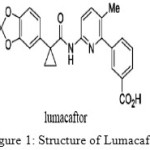 |
Figure 1: Structure of Lumacaftor. Click here to View figure |
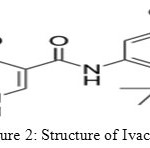 |
Figure 2: Structure of Ivacaftor. Click here to View figure |
Materials and Methods
Instrumentation
The chromatography was performed on a Waters 2695 HPLC system, equipped with an auto sampler, UV detector and Empower 2 software. The analysis was carried out at 254 nm with an inertsil ODS (4.6 x 250mm, 5mm) dimensions at ambient temperature(250c).
Chemicals and reagents
Ivacaftor and Lumacaftor were supplied fromMylon laboratories, Hyderabad. Orthophosphoric acid (OPA) (Merck),Methanol(MERCK HPLC grade) Acetonitrile (Molychem, HPLC grade) and Water for HPLC (LICHROSOLV (MERCK). were employed in the present work.
Preparation of solutions
Preparation of buffer
1ml of Orthophosphoric acidin1000 ml of HPLC water. The PHis adjusted to 3.0with TEA. The final solution is filtered through 0.45 m membrane filter and sonicate it for 10 mins.
Preparation of mobile phase
Accurately measured 600 ml (60%) of PH=3.0 buffer and 300 ml(30%) of Acetonitrile and 100ml(10%) of Methanol. mixed and degassed in an ultrasonic water bath for 10 minutes and then filtered through 0.45 µmmembrane filter under vacuum filtration. Figure4 represents the Chromatograms of mobile phase(blank solution).
Diluent Preparation
The Mobile phase was used as the diluent.
Preparation of standard stock solution
20 mg of Lumacaftor and 12.5 mg of Ivacaftorwere accurately weighed and transferred into a 10 ml clean dry volumetric flask.Add about 7 mL of Diluent and sonicate to dissolve it completely and make volume up to the mark with the same solvent.
Further, 1.5 ml of the above prepared stock solution is pipetted into a 10ml volumetric flask and dilute up to the mark with diluent.
Preparation of Sample Solution
Accurately weighthe samples of 10 tablets.It is crushed in mortor and pestle.Transfer equivalent to 20 mg ofLumacaftor and 12.5 mg Ivacaftor sample into a 10 mL clean dry volumetric flask.Add about 7 mL of Diluent and sonicate it up to 30 mins to dissolve it completely and make volume up to the mark with the same solvent.Then, it is Filtered through 0.44 micron Injection filter.
Further, pipette 1.5 ml of Lumacaftor and Ivacaftor from the above sample solution into a 10ml volumetric flask and dilute up to the mark with diluent. The standard solutions wereprepared on daily basis from which stock solutions were prepared.
Procedure
20 μL of the standard, stock and sample solution are injected into the chromatographic system. The areas are measured for Lumacaftor and Ivacaftor peaks are calculated.The %Assay by using the standard formula.
Method development and selection of wavelength
UV spectrum of 10 µg/ml Lumacaftorand 10 µg/ml Ivacaftor in diluents (mobile phase composition) are recorded by scanning in the range of 200nm to 400nm. The UV Spectrum obtain for From the UV spectrum LumacaftorandIvacaftoris shownin thefigure.1.Form the UV spectrum , the wavelength is selected as 254 nm. At this wavelength both the drugs show good absorbance.
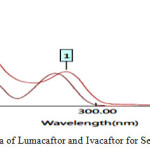 |
Figure 3: UV Spectra of Lumacaftor and Ivacaftor for Selection of Wavelength. Click here to View figure |
Construction of calibration curve
Aliquots of different concentrations of standard solution were prepared and their chromatograms were recorded at the optimized chromatographic conditions. The mean peak areas at different concentration levels were calculated from the chromatograms. Then the linearity plot was constructed using the mean peak areas at their respective concentrations. (Figures 8 &9)
Method of Validation
The developed method was validated for linearity, accuracy, precision, and limit of detection, limit of quantitation, robustness and system suitability parameters as described in ICH guidelines.
Linearity
From the stock solution, 100, 200, 300, 400, 500μg/ml solutions for Lumacaftor and 62.5, 125, 187.5,250, 312.5μg/ml solutions for Ivacaftor were made and their chromatograms were recorded. From the recorded chromatograms, their respective mean peak areas were calculated and the linearity plot was constructed using the mean peak areas at their respective concentrations. The correlation coefficient was found to be 0.999. The linearity data of Lumacaftor and Ivacaftorare shown in the Tables 1 & 2.The calibration plots, are given in the figures 4&5.
Table 1: Showing assay results.
| S. No | Name of compound | Amount taken(mg) | %purity |
| 1 | Lumacaftor | 200mg | 100.39 |
| 2 | Ivacaftor | 125mg | 100.17 |
Table 2: Linearity results for Lumacaftor.
| S. No | Linearity Level | Concentration(mm/ml) | Area |
|
1 |
I |
100 |
65792 |
|
2 |
II |
200 |
98696 |
|
3 |
III |
300 |
131638 |
|
4 |
IV |
400 |
162911 |
|
5 |
V |
500 |
200063 |
|
Correlation Coefficient |
0.999 |
||
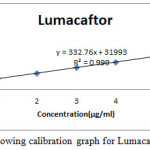 |
Figure 4: Showing calibration graph for Lumacaftor. Click here to View figure |
Table 3: Linearity results for Ivacaftor.
| S. No | Linearity Level | Concentration(mm/ml) | Area |
| 1 | I | 62.5 | 71267 |
| 2 | II | 125 | 99725 |
| 3 | III | 187.5 | 127369 |
| 4 | IV | 250 | 155275 |
| 5 | V | 312.5 | 179461 |
| Correlation Coefficient | 0.999 | ||
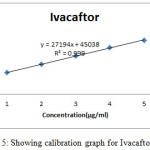 |
Figure 5: Showing calibration graph for Ivacaftor. Click here to View figure |
Results and Discussion
The present investigation reported by the authors are to develop a new validated method for the simultaneous estimation of Lumacaftor and Ivacaftor by RP-HPLC method. Mobile phase contains the mixture of 60% PH 3 Buffer(1ml OPA in 1000ml water) and 30% of Acetonitrile and 10% of Methanol. It is used as diluent in the present study. An intersil ODS column of 5μ (4.6X250mm) is employed for the simultaneous determination of Lumacaftor and Ivacaftor by RP-HPLC method. A flow rate of 1ml for minute is used in this method. UV detection wavelength at 254mm and temperature of 25oC were maintained. Two sharp peaks were obsorbed at 3.101mts and 4.025 mts for Ivacaftor and Lumacaftor respectively. The representative chromatograms of blank solution, Lumacaftor and Ivacaftor shown in this figure.4 Chromatograms of assay of sample injection and standard of sample injection are shown in the figures5 & 6 and assay results of purity in the table 1. The % purity of Lumacaftor and Ivacaftor were found to be 100.39 and 100.17 respectively.
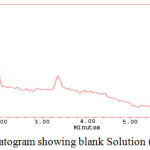 |
Figure 6: Chromatogram showing blank Solution (mobile phase). Click here to View figure |
Linearity
Figures 7a to 7e represent the chromatograms showing different linearity levels with different concentrations of Lumacaftor and Ivacaftor and results of given in the tables 2 & 3. Both Lumacaftor and Ivacaftor obey Beer Lamberts Law in the range of concentrations of100µg /ml to 500 µg /ml and 62.5µg /ml to 312.5µg/ml respectively with regression equations Y= 332.76 X + 31993(correlation and coefficient) R2= 0.999 for Lumacaftor and Y= 27194 X + 45038 , R2= 0.999. forIvacaftor.
Precision
This validated method is more precise and the percentage of relative standardization (%RSD) and intermediate precision / Ruggedness were found to be 0.8 and 0.7 for Lumacaftor and 0.8 and 0.6 for Ivacaftor . The results are given the in the tables 6 and 7.
System suitability
The results for Lumacaftorand Ivacaftor are given in the tables 473. It was performed to ensure that complete testing system was suitable for the intended application. The USP tailing factor for Lumacaftorand Ivacaftor were 1.58 and 1.15 which is <2 and the USP plate found were 2693.56 and 2310.88 which is >2000 the results for actual flow of 1.0ml/min is considered from assay standard. Tablets for all shows system suitability results with change in the organic composition in the mobile phase for Lumacaftorand Ivacaftorchromatograms of and Lumacaftorand Ivacaftorare show in the figures 12 and 13.
Accuracy
The accuracy study was performed for 50%, 100% and 150 % for Lumacaftorand Ivacaftor. Each level was injected in triplicate into chromatographic system. The area of each level was used for calculation of % recovery. These results were given in the tables 4 & 5. The Mean % of recovery is 100.53 forLumacaftor and 100.13 for Ivacaftor.(NLT 98% and NMT 102%)
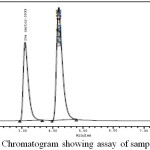 |
Figure 7: Chromatogram showing assay of sample injection. Click here to View figure |
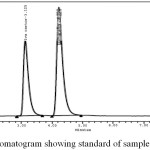 |
Figure 8: Chromatogram showing standard of sample injection –Linearity. Click here to View figure |
Linearity
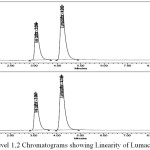 |
Figure 9: a,b Level 1,2 Chromatograms showing Linearity of Lumacaftor and Ivacaftor. Click here to View figure |
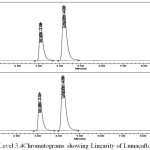 |
Figure 9: c,d. Level 3,4Chromatograms showing Linearity of Lumacaftor and Ivacaftor. Click here to View figure |
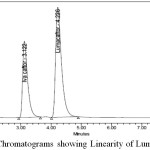 |
Figure 9: e. Level 5 Chromatograms showing Linearity of Lumacaftor and Ivacaftor. Click here to View figure |
Table 4: Linearity results for Ivacaftor.
| S. No | Linearity Level | Concentration(mm/ml) | Area |
| 1 | I | 62.5 | 71267 |
| 2 | II | 125 | 99725 |
| 3 | III | 187.5 | 127369 |
| 4 | IV | 250 | 155275 |
| 5 | V | 312.5 | 179461 |
| Correlation Coefficient | 0.999 | ||
Accuracy
The accuracy study was performed for 50%, 100% and 150 % for Lumacaftor and Ivacaftor. Each level was injected in triplicate into chromatographic system. The area of each level was used for calculation of % recovery.
The accuracy results for Lumacaftor
Table 5: Showing accuracy results for Lumacaftor.
| %Concentration(at specification Level) | Area | Amount Added(mg) | Amount Found(mg) | % Recovery | Mean Recovery |
| 50% | 67838.3 | 10 | 10.00 | 100.02 | 100.53 |
| 100% | 136568.7 | 20 | 20.13 | 100.67 | |
| 150% | 205309.3 | 30 | 30.27 | 100.90 |
Table 6: Showing accuracy results for Ivacaftor.
| %Concentration(at specification Level) | Area | Amount Added(mg) | Amount Found(mg) | % Recovery | Mean Recovery |
| 50% | 60620.7 | 6.25 | 6.27 | 100.37 | 100.13 |
| 100% | 121845 | 12.5 | 12.61 | 100.87 | |
| 150% | 179676 | 18.75 | 18.59 | 99.16 |
Precision
Table 7: Showing% RSD results for Lumacaftor and Ivacaftor.
| Injection | Area for Lumacaftor | Area for Ivacaftor |
| Injection-1 | 141368 | 128876 |
| Injection-2 | 140717 | 127224 |
| Injection-3 | 142655 | 129055 |
| Injection-4 | 143939 | 128739 |
| Injection-5 | 143013 | 126699 |
| Injection-6 | 142282 | 129220 |
| Average | 14239 | 128302.2 |
| Standard Deviation | 1156.8 | 1064.1 |
| %RSD | 0.8 | 0.8 |
Intermediate precision/Ruggedness
Table 8: Showing results for intermediate precision of Lumacaftor and Ivacaftor.
| Injection | Area for Lumacaftor | Area for Ivacaftor |
| Injection-1 | 139453 | 122535 |
| Injection-2 | 137162 | 121224 |
| Injection-3 | 139458 | 122915 |
| Injection-4 | 138377 | 123391 |
| Injection-5 | 138482 | 123108 |
| Injection-6 | 139771 | 122959 |
| Average | 138783.8 | 122688.7 |
| Standard Deviation | 976.1 | 769.7 |
| %RSD | 0.7 | 0.6 |
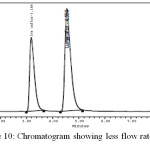 |
Figure10: Chromatogram showing less flow rate. Click here to View figure |
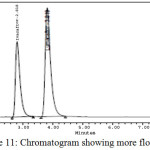 |
Figure11: Chromatogram showing more flow rate. Click here to View figure |
Table 9: System suitability results for Lumacaftor.
| S. No | Flow Rate (ml/min) | System Suitability Results | |
| USP Plate Count | USP Tailing | ||
| 1 | 0.9 |
2910 |
1.16 |
| 2 | 1.0 |
2310.88 |
1.58 |
|
3 |
1.1 |
2245.12 |
1.13 |
Table 10: System suitability results forIvacaftor.
| S. No | Flow Rate (ml/min) | System Suitability Results | ||
| USP Plate Count | USP Tailing | USP Resolution | ||
| 1 | 0.9 | 3425.70 | 1.19 | 3.62 |
| 2 | 1.0 | 2693.11 | 1.16 | 3.43 |
| 3 | 1.1 | 2675.84 | 1.17 | 3.35 |
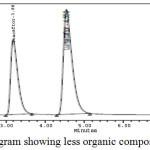 |
Figure 12: Chromatogram showing less organic composition in the mobile phase.Click here to View figure |
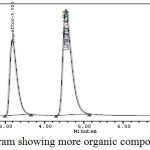 |
Figure 13: Chromatogram showing more organic composition in the mobile phase. Click here to View figure |
Table 11: Showing system suitability results for Lumacaftor.
| S. No | Change in Organic Composition in the Mobile Phase | System Suitability Results | |
| USP Plate Count | USP Tailing | ||
| 1 | 10% less | 2425.70 | 1.21 |
| 2 | *Actual | 2310.88 | 1.58 |
| 3 | 10% more | 2705.45 | 1.12 |
Table 12: Showing system suitability results for Ivacaftor.
| S. No | Change in Organic Composition in the Mobile Phase | System Suitability Results | ||
| USP Plate Count | USP Tailing | USP Resolution | ||
| 1 | 10% less | 2910.66 | 1.16 | 3.61 |
| 2 | *Actual | 2693.11 | 1.16 | 3.43 |
| 3 | 10% more | 2248.50 | 1.12 | 2.96 |
Detection limit
As per ICH guidelience S/N Ratio value shall be 3 for LOD solution.
As per ICH guidelience S/N Ratio value shall be 10 for LOQ solution.
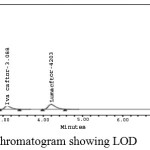 |
Figure14: Chromatogram showing LOD. Click here to View figure |
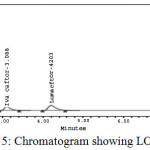 |
Figure 15: Chromatogram showing LOQ. Click here to View figure |
Conclusion
The proposed HPLC method was found to be simple, precise, accurate and sensitive for the simultaneous estimation of Lumacaftor and Ivacaftorin pharmaceutical dosage forms. The results are accordance with ICH guidelines. Hence, this method can easily and conveniently adopt for routine quality control analysis of Lumacaftor and Ivacaftor in pure and its pharmaceutical dosage forms.
Acknowledgment
Authors are thankful to the Pharma Train Lab, Kukatpally, for providing instrumental and analytical support. We extended our thanks to the Principal and Management for their timely help.
References
- Alter, M.J.; Hepatology. 1997, 26, 62-65
CrossRef - Benhamou, Y.; DeMartinio, V.; Bochet, M.; Colombet, G.; Thibault, V.; Liou, A.; Katlama, C. Hepatology, 34, 283-287
CrossRef - “Elbasvir Hydrochloride”. The American Society of Health-System Pharmacists. Retrieved Jan 2016.
- Hirst, J.; Farmer, A. J.; Ali, R.; Roberts, N. W.; Stevens, R. J. 2012, 35(2), 446-54
- Lilian, B. A. R.; Marilia, B. G. Elbasvir: an old but still the best treatment for type 2 diabetes, 2013
- Arayne, M. S.; Najma S.; Hashim, Z. Pak. J. Pharm. Sci., 2006, 19(3), 231-235.
- Teng, X .W.; Foe, K.; Brown, K.; Cutler, D. J.; Davies; J. Pharm. Biomedi. Anal. 2001, 26, 313-19
CrossRef - Shaikh, S.; Muneera, M.S,; Thusleem, O.A Orient. J. Chem., 2013, 29(2), 579-587.
- Kondaguli, A.V. Jour. of Chromatographic Sci., 2009, 47(2), 178-183
CrossRef - Ravi, R. Y.; Manoj, D. R., Deepali M. G.; Ganesh S. Holkar. Intern. Jour. of Theo. & Appl.Sci. 2012, 4(2), 145-156
- Kabeer, A. S.; Ashish, T. P. Jour. of Trace Analysis in Food and Drugs, 2013, 1, 14-21
- Yadav, R.R.; Rokade, M.D.; Salunke, S.A.; Gangrade, R.M.; . Holkar, G.S. V.N. Biological Forum – An Int. Jour. 2009, 4(21), 1128(-21071
- Hiral, N. D.; Ashlesha, G. M.; Chaitanya, B.; Killambi, P. k.; Inter. Jour. of App. Sci. and Eng. 2011, 9, 177-185
- Ravi, G.; Padmakar, A.; Sudesh, B.; Biological Forum – An International Jour.2013, 5(1), 33-41
- Heidurnezhad, Z,; Heydari, F.; Bahranian, E. Orient. J. Chem., 2013, 29(1), 69-74
- Rajesh, M. K.; Santosh, G. S.; Shrawan, S.; E-Jour. of Chem., 2011, 8, 340-346
CrossRef - Soleymani, R.; Dehgharian, A.; Ebtesam, S., Orient J. Chem., 2012, 28(4), 1291-1304
- Abdollahpour, A.; Forouhi, M.; Shamsipur, M.; Yamini, Y. J. Iran. Chem. Soc., 2010, 7, 516-520
CrossRef - Holkar, G.S.; Rokade, M.D.; Yadav, R.R.; Daphal, V.N.; Int. Jour.of Theo. & App. Sci., 2012, 4(2), 56-65
- Gopalakrishnan, S.; Chitra, T.A.; Aruna, A.; Chenthilnathan, A. Der. Pharma. Chemica, 2002, 4, 1003-1015
- Geetha, M.; Venkat, R.; ShakilL, S.; Sripal, R. P. Orient. J. Chem. 2013, 29, 579-587.
CrossRef

This work is licensed under a Creative Commons Attribution 4.0 International License.









